Is your social media strategy directed to get your business in front of millions of people? Or to get your posts viral, buzzing with lots of likes and shares? That’s perfect. But in this race, many overlook the bigger picture—the ultimate goal of driving traffic to their website.
After all, the real purpose of social media isn’t just to spark interest; it’s to lead people to your website, where they can explore your product, understand its value, and ultimately become loyal customers.
So, how do you inspire users to leave their endless scrolling and step into your website? The answer lies in smart, intentional social media marketing strategies. At Socialinsider, we’ve tested 14 powerful tactics, and we’re ready to share these proven methods to help you increase your social media traffic. Let’s dive in!
Table of contents
What is social media traffic?
How to increase traffic on social media?
#1. Use employee-generated content
#2. Conduct and share industry research
#3. Leverage outbound engagement
#4. Utilize User-Generated Content (UGC)
#5. Cross-promote your social media channels
#6. Optimize social media content for SEO
#7. Partner with influencers
#8. Continuously engage with your community
#9. Capitalize on social media trends
#10. Be consistent with posting
#11. Run product ads
#12. Use social media analytics tools
#13. Use a customer service chatbot
#14. Be active in social media groups and communities
What is social media traffic?
Social media traffic refers to the visitors who land on your website or online store through your social media platforms. For example, a user may land on your Instagram post, get curious about your products, and visit your website through the link in the bio.
There are two types of social media traffic:
- Organic traffic: This comes from unpaid social media efforts, such as posts, reels, or shared links. For example, when someone clicks on the link in your Instagram bio or a Facebook post you shared.
- Paid traffic: This comes from paid ads on social media platforms, such as sponsored posts or targeted ads, where you promote links to drive users to your site.
Social media traffic is one of the strongest determinants of your overall social media strategy's performance. It measures how well your social media efforts convert into actionable interest in your brand, products, or services.
How to increase traffic on social media?
Whether you want to increase traffic to your blog or nudge people towards your free trial, social media is a great way to do that. With billions of users across platforms, you have lots of opportunities to drive them to your website.
Let’s look at each of them.
1. Use employee-generated content
Employee-generated content (EGC) refers to any marketing content created by your employees for your brand. This could mean an employee sharing a post on LinkedIn about how they use your tool. Or featuring them on your brand’s account.
This boosts traffic in social media in two ways:
- Builds trust: According to research, people trust company experts 66% of the time. With EGC, employees talk about their daily lives, the product, or share personal stories. This trust encourages people to click on shared links and explore the website.
- Expands reach: Employees often have diverse networks across social media. When they share content, it might reach people who do not follow your company’s official channels. This broadens your audience and increases the chance of boosting social media traffic.
The catch? You have to be strategic with EGC creation. Here are three impactful EGC ideas to drive traffic on social media.
Create employee advocacy programs
These programs involve creating guidelines to support content creation, incentivizing employees through gamification or shout-outs, and monitoring results.
For example, VEED.IO is one company whose employees create a lot of content on social networks. You’d find them sharing tips, their processes, milestone achievements, and some fun posts. Here’s an example from their senior social media manager, Brian Da Silva.
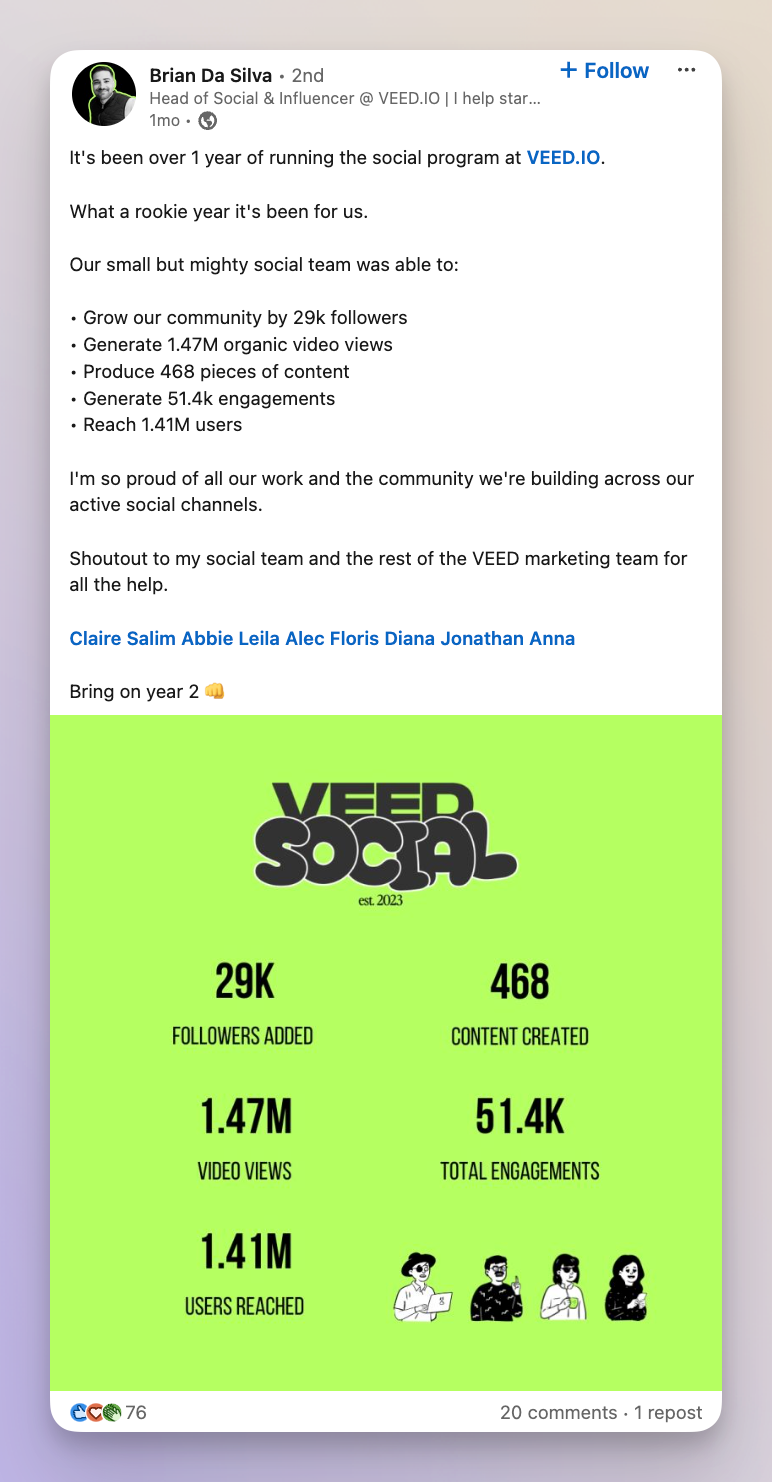
Share a day in the life series for different job roles
Let employees share what they do every day at the office. This lets your users know the people behind the company and build a personal connection. Here’s an example from Innocent, a healthy drinks company.
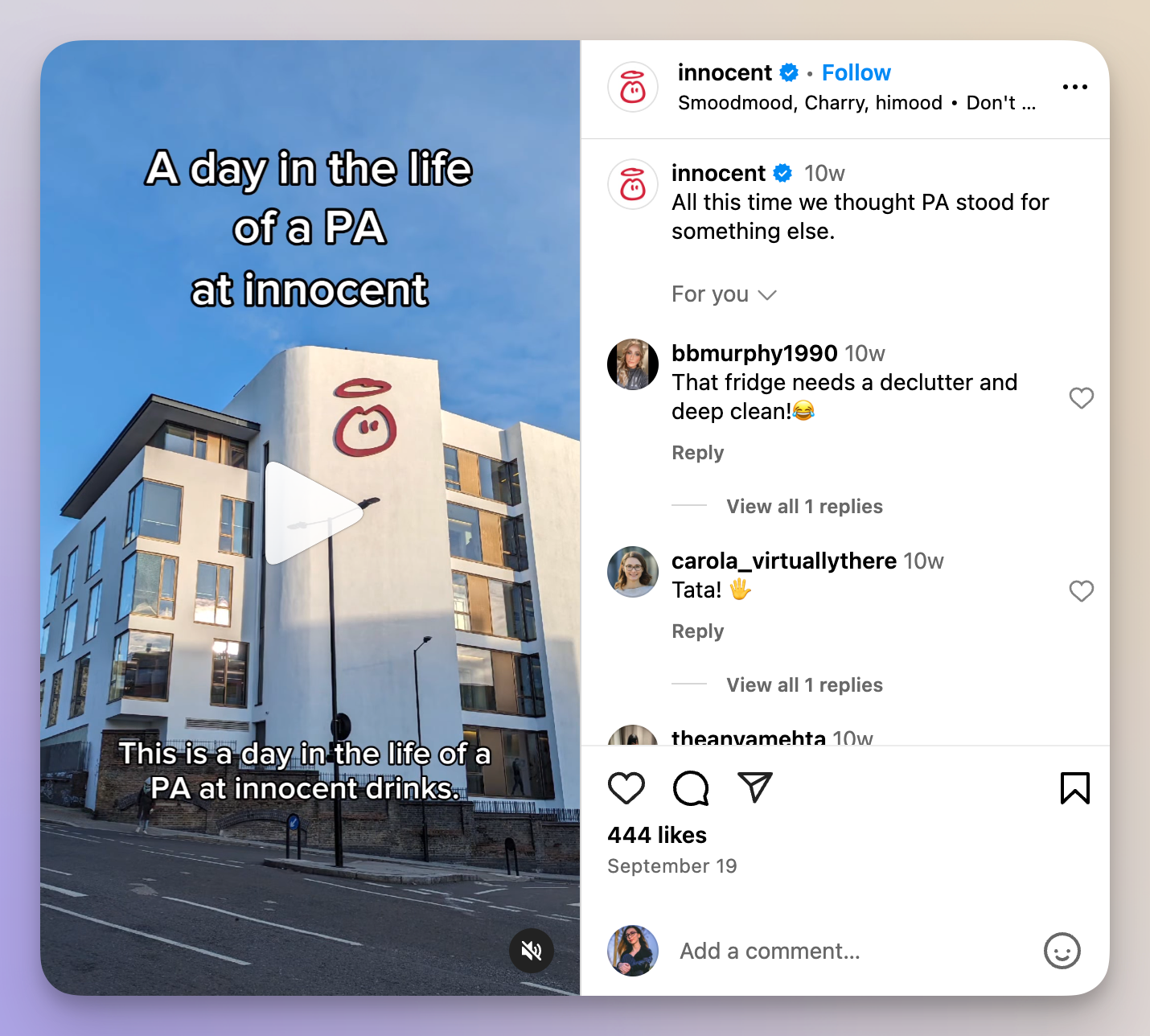
Do an office tour in a funny way
Employee-generated content doesn’t have to be boring. Add wit, humour, and fun perspectives to create content that engages people and motivates them to check out your company/website.
Here’s how our social media manager, introduces our office in a fun, GenZ way to boost social traffic.

#2. Conduct and share industry research
Many businesses conduct industry research to provide unique insights to their audience. Think of Mailchimp in email marketing. Or Salesforce in the CRM field. Or even Asana in the project management niche. All of these companies regularly publish reports and studies.
It’s a way to establish thought leadership, enhance credibility, and showcase expertise in their industry. But it does not end there. You can publish these insights on social media and drive traffic to your original reports published on the website.
Here are three ways to get traffic on social media using this tactic.
Conduct surveys
Involve other thought leaders/potential customers in your surveys. Ask them questions and get their insights on a particular topic.
For example, if you’re in the email marketing niche, you can conduct surveys on email marketing benchmarks or email marketing strategies that worked wonders for companies.
Here’s an example of surveys our founder, Adina Jipa, conducts on LinkedIn to gain insights from social media managers.

Aggregate and analyze data
Do you collect data from your in-app usage? Or do you conduct yearly reports to present unique findings about the industry? This data can be repurposed into infographics for social media. These insightful findings nudge people to visit your website and read the entire report.
For example, we shared insights from our LinkedIn engagement benchmarks report and gained 200 followers on LinkedIn in a day.

Here’s the LinkedIn post that generated this social media growth:

Partner with other data providers
Partnering with other data providers can help you reach a wider audience. At Socialinsider, we partnered with Data Reportal to provide data across platforms and regions. This helped bring unique visitors to our website and drive more traffic on social media.
#3. Leverage outbound engagement
Is social media all about creating content? No. To grow your traffic on social media, you need to keep attracting more people to your accounts. One of the easiest ways to do that is by engaging with people in your niche.
Here are three types of accounts you should engage with – subject matter experts (thought leaders, influencers, and celebrities in your niche), non-competitive brand accounts that serve the same target audience, and potential customers.
At the same time, you don’t want to leave comments that are cringe. Or worse-yet, that have AI written all over them. People will not spend more than a second unfollowing you if they detect AI-generated comments.
Here are our five tips on getting outbound engagement right to increase traffic on social media.
- Avoid generic comments like “Great post” or “Nice share.” Instead, reference something from the post and add your personal insights to it.
- Use a conversational tone. Don’t sprinkle jargon or overly complicated words. The best way to do this is – write as if you’re talking to a friend.
- Stay on brand. Maintain a tone that aligns with your brand’s voice while still being personable.
- Avoid over-the-top promotions. Focus on contributing to the discussion, not selling your product or service. If you do promote, do it subtly and only when it’s genuinely helpful.
- Leave witty or funny comments. This shows a different side of your brand and gets better engagement. Take a look at how we do it.

#4. Utilize user-generated content (UGC)
Think of your favorite brands on social media. Do they post educational content? Absolutely. But do they also share reviews or experiences from their users? Yes. Ever wondered why? It’s because UGC builds strong social proof. And this type of content is fun to engage with.
It also draws people to your profile, which can naturally boost your social media traffic.
Here are three ways we recommend using UGC.
Run contests and giveaway
Contests and giveaways draw a lot of attention. The motivation to win something can lead to virality, directing new people to create UGC.
You can even host this content on your website and promote it through your social profiles. This way, you can ask people to enter the contest on the website and get more traffic from social media.
Here’s a great example from Mob Kitchen. They ask users to upload photos of their recipes on the website, building strong social proof.

Crowdsource content
Do brands like Apple or Photoshop have to work hard to generate UGC? Not really. It’s because they know how to crowdsource content. Take Photoshop’s #MadeWithPhotoshop example. It has over 365K posts on Instagram alone.
How to do this? Encourage people to share UGC with a branded hashtag. Look how Adobe promotes it in their bio.

Encourage users to share content around your event
Whether it’s a webinar, conference, or a gathering of SMEs in your field, encourage attendees to share selfies and screenshots on social media. This creates curiosity around your brand and encourages people to seek more information about your brand, driving traffic to the website.
Here’s an example from Semrush’s event.
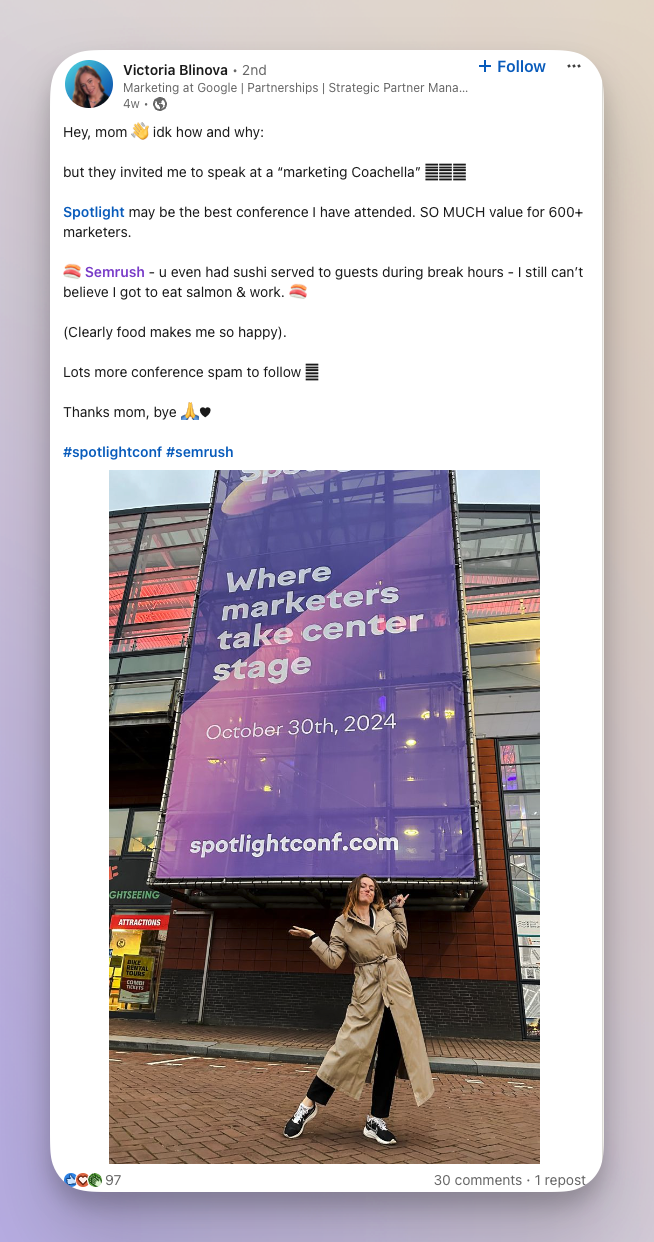
#5. Cross-promote your social media channels
Is TikTok working great for your business? What if you could use it to grow your other social accounts? With cross-promotion, you can help users find your other social profiles.
How does this help increase social media traffic? Each social platform has unique audiences and features, and cross-promotion allows you to tap into those differences.
For example, you might post a teaser video on TikTok with a call-to-action (CTA) that says, “Check out the full video on YouTube. Link in bio!” This strategy ensures every audience gets a tailored message, ultimately generating website traffic from social media.
Below are three ideas to get started.
Invite people to follow other branded communities
Do you have a community on Facebook? And a separate one online? Cross-promote these communities to engage your audience wherever they are most active.
When you do this, ensure you craft unique content and conversations in these communities. If you post the same thing everywhere, people will have no incentive to join your different communities.

Promote your social channel
Insert links or QR codes to your social channels everywhere. For example, getting traffic on social media from your business card, newsletter, and even email marketing campaigns.
Share your social posts in your blog articles
Interlinking your website and social accounts is a great strategy to boost your brand's visibility in the online sphere, offering your potential clients the opportunity to get a deeper understanding of your company quickly.
So, make sure to share relevant social posts in your blog articles with a CTA to follow you for more insights on that particular platform.
#6. Optimize social media content for SEO
Social platforms like YouTube and TikTok are turning into search engines. Enter a keyword and you have a list of search results. All brands want to be at the top of these search results. One way to do that is through SEO optimization.
With strategic SEO practices, your content can appear at the top, attract more visitors, boost brand authority, and lead to an increase in traffic and engagement.
Here are five practices that will help attract traffic on social media.
Optimize profiles for SEO
To drive visitors to your account, start by creating a strong, keyword-rich profile description. When a user searches for your niche, your account should pop up. You can even add location and website links to your profile to boost discoverability.
Use strategic hashtags
Hashtags make it easy for your content to reach the right people. Instead of using generic hashtags, create branded ones. Or conduct a competitor analysis to see which hashtags work best for your competitors.
Add ALT text
ALT text allows social algorithms to understand your visual content and help in search rankings. It also helps visually challenged people know what your content is about. While writing this text, be descriptive yet concise.
Optimize images and videos for mobile
Almost everyone uses social media on their phones. If your videos don’t load or your images are not sized properly for mobile, you’ll create a bad user experience, dissuading them from visiting your website.
Ensure your website is mobile-friendly
Your users will tap on the website link in your bio or in the comments. This will likely happen on mobile. Hence, your website should be optimized for mobile. Otherwise, the traffic increase would not lead to conversions.
#7. Partner with influencers
Influencer marketing is a great way to reach a wider audience and drive more traffic. Creative influencer-generated content also garners a lot of engagement, leading to more exposure.
One way to do this is by running ambassador programs. You can get a lot of micro and nano influencers to run promotions for your brand using this approach. These influencers also cater to a niche audience, leading to a quality traffic boost.
But what are some essentials when working with influencers?
Be clear about your goal. This will set the grounds for everything about the campaign– influencers you pick, content guidelines you share, and social media metrics you need to track.
For example, if you want to lead people to try your new product, pick influencers in your niche who regularly test new products. Or those who have tested a competitor product in the past.
Share content guidelines about the features/benefits you want them to emphasize. Mention the CTA. Say, subscribing to a limited-time free trial. And discuss the compensation and how metrics might play an important role in that.

#8. Continuously engage with your community
Social media is a two-way street. You can’t expect to get results from it if you just schedule posts and call it a day. After all, nobody likes following brands who are there just to get likes, shares, and comments. People expect brands to interact with them.
Below are three ways to keep your audience engaged and improve traffic.
Respond to every comment
When brands respond, customers feel valued and are more likely to engage again. This approach humanizes the brand and demonstrates active listening.
Additionally, engaging with comments can increase post visibility due to social media algorithms prioritizing interactions, potentially acting as a traffic booster.
Here’s how Semrush responds to almost every comment on their TikTok video.

Respond to DMs
Unread DMs and, worse yet, DMs left on seen frustrate users. You can even risk potential customers and damage your reputation. By responding promptly, you show customers that their concerns matter.
One brand that I love for its response is Zappos. They often use DMs to assist with order inquiries or resolve complaints. Many times, they even redirect customers to their website, which has a detailed support section.
Promote your IRL events on social media
Thinking of generating traffic on social media from your brand’s real-life events? It’s not that challenging. All you need to do is build hype around your event.
Once the event is over, share photos of the key attendees and quickly discuss major learnings/updates.

#9. Capitalize on social media trends
Social media trends help you uncover different types of content that drive website traffic. For example, you can create a reel on a piece of trending music or use a viral meme and tweak it to your niche.
With trends, it’s important you strike while the iron is hot. As many trends often have a short shelf life, you need to engage when the audience’s interest is at its peak. Also, ensure you pick relevant trends to drive traffic. Otherwise, you’ll attract people who are not the ideal fit for your brand.
But how do you discover these trends in the first place?
- Use social listening tools. These tools help identify trending topics and conversations in your industry. You can just enter niche-specific keywords and spot emerging trends and what your audience is discussing.
- Monitor influencers and creators. These accounts are the first to spot trending conversations and create content around them.
- Leverage trend-finding platforms. Platforms like Google Trends and Trendhunter analyze search and conversation data to identify patterns that are gaining popularity.
- Follow hashtags. Platforms like Twitter highlight trending hashtags in the “Trending” section. This gives you an idea of popular discussions happening on social media.
That’s not all. You can even use Socialinsider to track how your content on social media trends is performing. For example, you can analyze post formats. If you are covering a trend using multiple content formats, this is a great way to see which content type is resonating the most with your audience.

Another thing we often do is use the AI content pillars feature. It shows us the trending content topics by engagement.
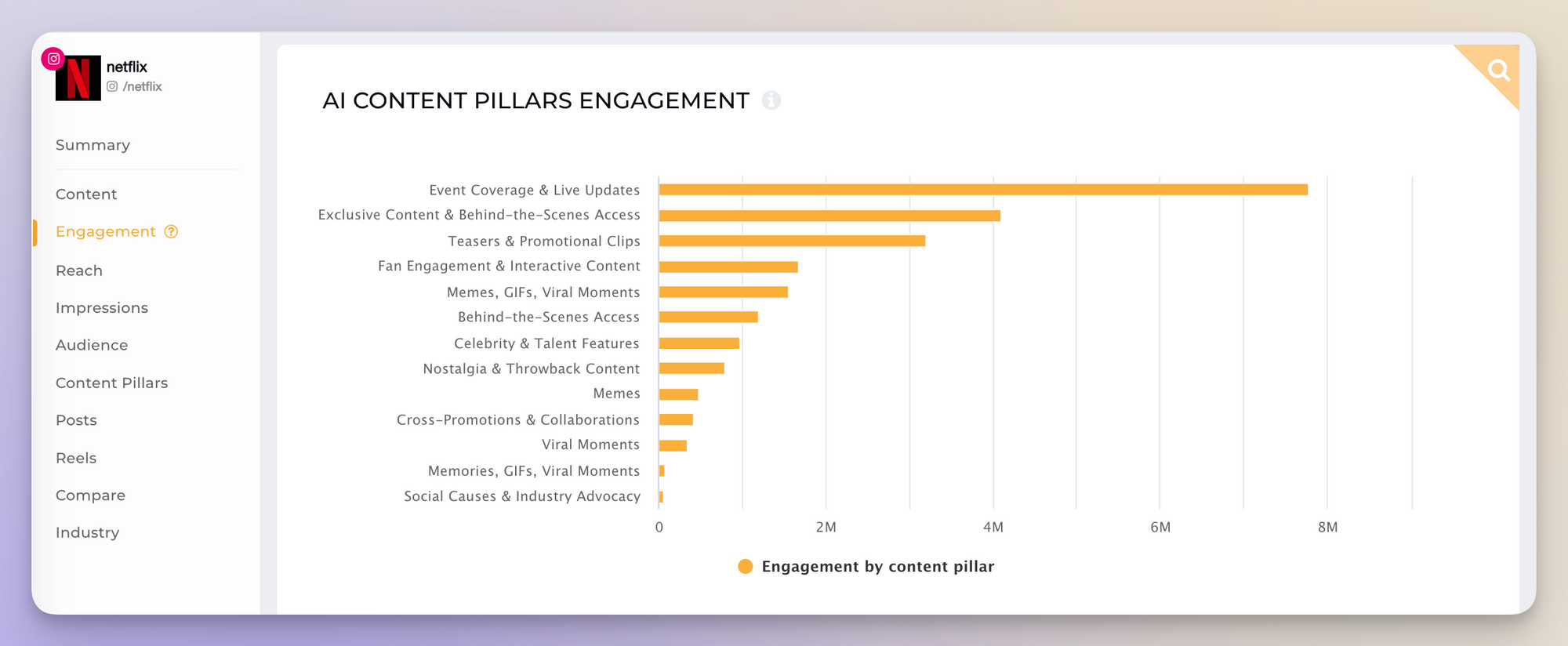
We use it to understand audience preferences and create more content that resonates with them. This way, we keep them engaged and direct this engagement to our website.
#10. Be consistent with posting
There’s never one single answer to the question – how to drive traffic on social media. However, one golden rule applies across all strategies: consistently show up with fresh, engaging content.
The more consistently you post, the greater your chances of engaging your audience. This also naturally boosts website traffic generation through social media.
Here’s how you can do it.
Have a social media calendar
As a social media manager, you already have a lot of things on your plate. Why add “What to post today” to the mix? Instead, build a social media calendar.
You can use tools like Google Sheets or Notion to create this calendar. This is where you can jot down ideas you get throughout the day and schedule them.
You can have additional fields like content goal, media, KPIs, posting time, etc. The more detailed your content calendar, the higher the probability of posting content consistently.
Pro-tip: Be flexible with your calendar. For example, always make room for timely content. It could be a trending topic or a major event in your industry.

Post when your audience is most active
You want to post when your audience is most likely to interact with your content. While you can follow research reports on the ideal times to post, I recommend a different approach.
Run through the in-built analytics on platforms like Instagram and Facebook. Notice the hours and days when your audience is most active.
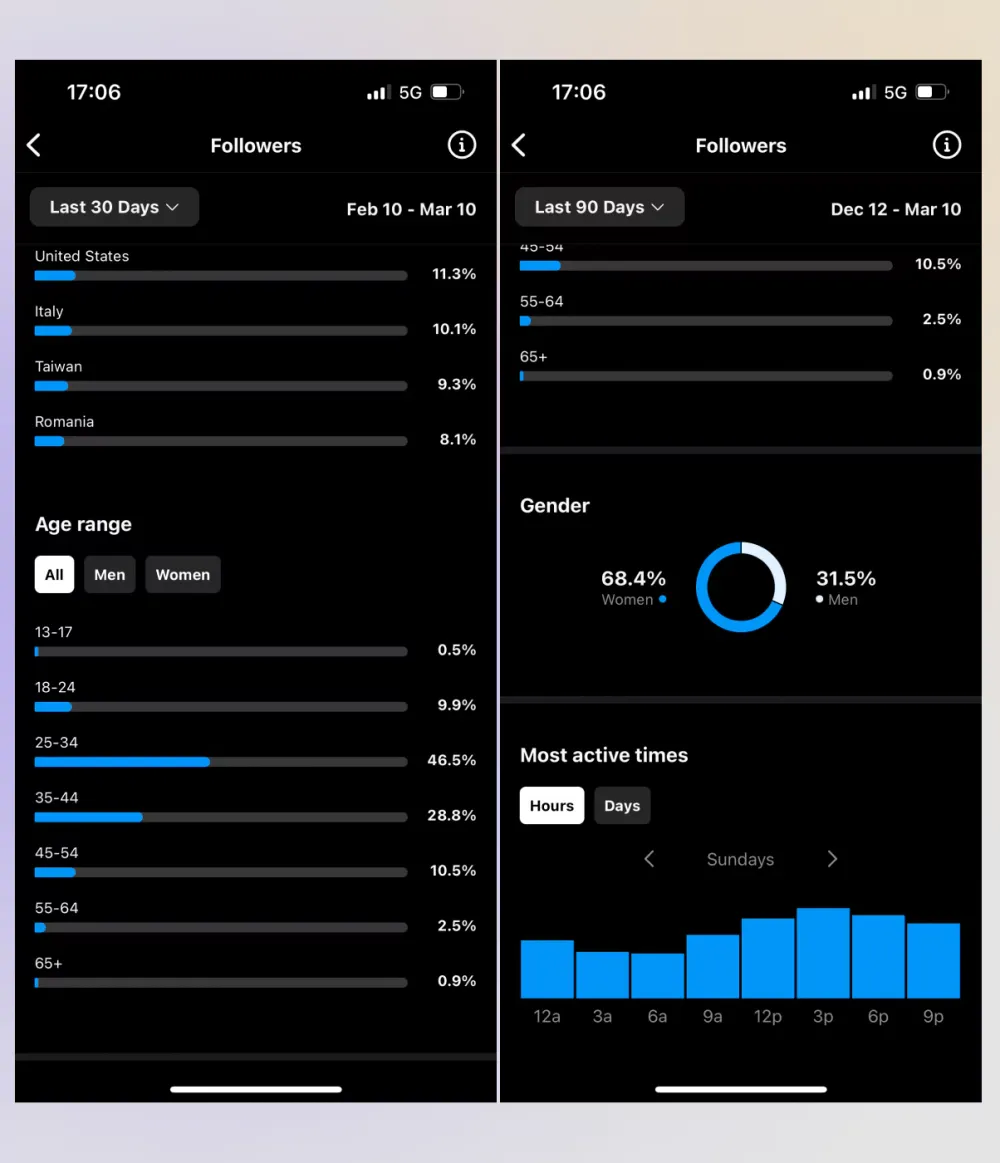
This will give you a great starting idea. If you want to dig deeper, go on Socialinsider. Our tool analyzes all your posts and gives you details on the day and time you receive the most engagement.

Keep that in mind while scheduling your next batch of content.
#11. Run product ads
Want some quick wins? It’s time to steer a little away from the organic track then. Paid ads on social media ensure you reach the right audience without relying on complex social media algorithms.
And the best part? Users can click on the link in the ads. This directly helps in generating website traffic from social media.
While running these ads, ensure you use a tailored approach for each platform. For example, a flashy video on Instagram might capture attention, but the same audience on LinkedIn might prefer a case study ad showcasing tangible value. This platform-specific nuance helps ensure your message resonates with its intended audience.
You will also have to choose between different ad options on different platforms. Say, in-feed ads, stories, and interactive carousels on Instagram. And text ads and direct messaging on LinkedIn.
These details will also help you choose the right platform if you’re working on a limited budget.
Here are a few other best practices you can keep in mind:
- Use high-quality images and videos to grab attention. Users on Instagram and TikTok prefer eye-catching visuals.
- Show how the product solves a problem or benefits the user. For example, demonstrate use cases or highlight unique features.
- Write concise copy that matches the tone of the platform. For example, on X, keep ads punchy and to the point.
- Ensure ads are designed for mobile-first viewing, with responsive designs and vertical formats for platforms like Stories and Reels.
- Leverage UGC. Include testimonials, reviews, and studies to build trust and authenticity.
Here’s an example of an ad by Zapier that incorporates some of these best practices.

#12. Use social media analytics tools
Have you ever wondered, “Why did this post not bring the desired engagement?” or “Why has our social media traffic dipped in the last few months?” Social media analytics tools let you dig deep and get answers to these questions.
You also don’t need to manually gather insights from different sources. With the time you save, you can focus on what truly matters: refining your social media strategy and crafting scroll-stopping content.
Here are three ways to use tools like Socialinsider.
Analyze your content
Content that gets high engagement usually has a better chance of driving more visitors to the website. Socialinsider lets you see your top and bottom-performing content in one pane. You can even quickly glimpse the content pillars.
For example, Calm’s top posts belong to two main content pillars - mental health and health tips & wellness advice.
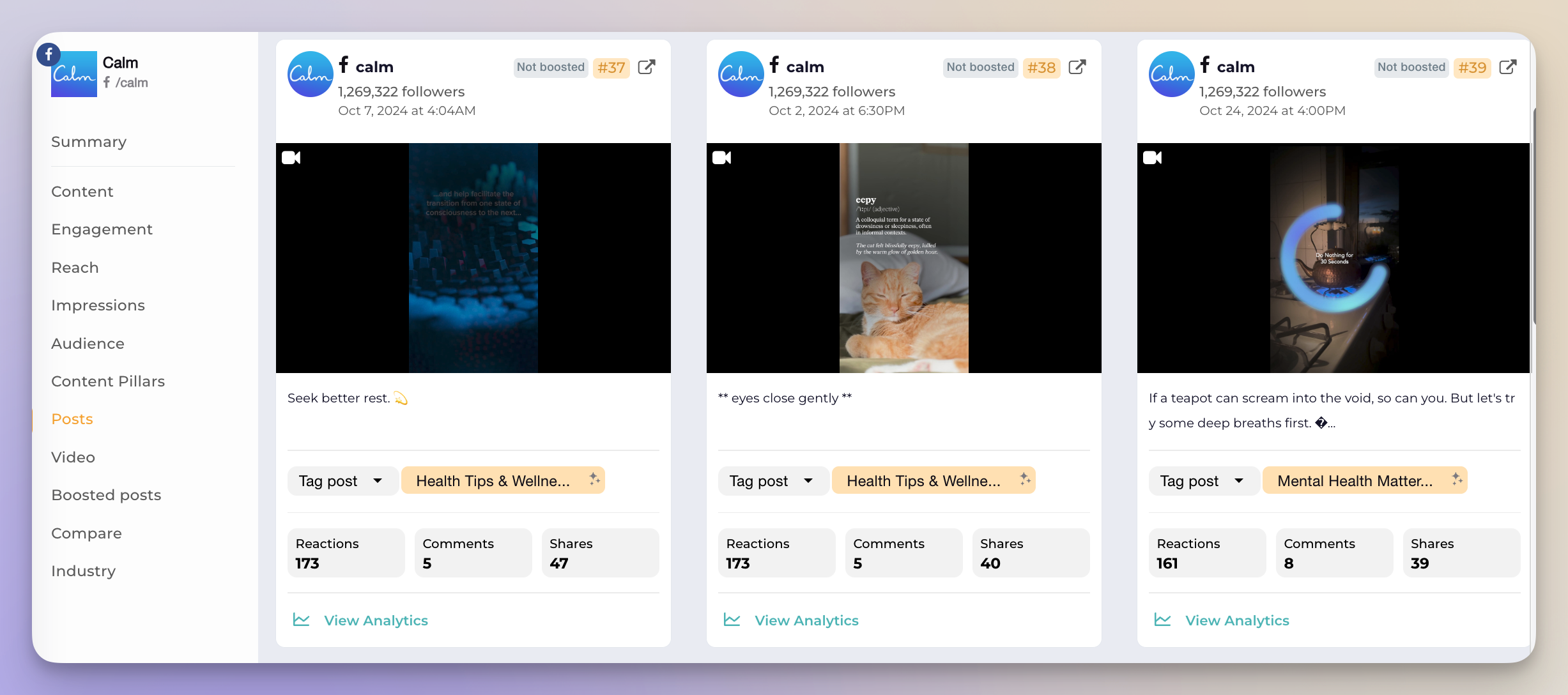
And their bottom-performing content are videos with no captions.
This quick analysis can guide their team on what to focus on and how to garner more visibility.
View progress over time
Have you adopted a different strategy? Or do you want to see if your engagement is increasing over time? Socialinsider lets you select a time period and gives detailed insights on engagement, reach, impressions, and follower growth. You can even compare results from one time period to other time period. Say, Halloween 2023 campaign vs Halloween 2024 campaign.
Based on these results, you can see if your social media strategy is actually working or not.
Get detailed reports
Depending on your requirements, you can schedule auto reports in Socialinsider to be emailed to you daily, weekly, monthly, or quarterly. These reports can be general engagement reports or benchmarking reports. For example, a comparison of your metrics to the industry average.
This can help you see trends over time, spot anomalies, and make better decisions on how to drive customers to your website.
#13. Use a customer service chatbot
You have probably encountered chatbots on websites. But you can use them for your direct messaging and drive users to your website. It can act as a virtual guide that bridges social media interactions with your site.
Here are a few ways how.
- Automate FAQs with links: When users ask common questions about your products or services, your chatbot can provide instant responses with relevant links to your website. For example, a question about pricing can be answered with, “Here’s our pricing breakdown,” followed by a direct link to your pricing page.
- Enable quick purchases: If you offer different product categories, chatbots can guide users toward specific products on your website. For example, a user might ask, “Do you offer email marketing services?” and the bot could reply, “Absolutely. Explore details here [link].”
- Promote content: If your website hosts valuable resources like articles, ebooks, or reports, you can share these as responses. This approach subtly drives users to your site for more information. For example, when someone leaves a DM about your email marketing services, as an ending note, you can drive them to your guide or case studies.
- Drive event sign-ups: If you’re hosting webinars or events, chatbots can answer inquiries and share the sign-up link.
#14. Be active in social media groups and communities
Wondering how to drive traffic to your site using Facebook? There are some really great Facebook groups and communities in every niche. Be it skincare or project management, you’ll find active communities where people discuss things and start valuable conversations.
These communities offer an easy way to find people with the same interests and inclination toward a particular niche. You can start engaging in relevant conversations, answer questions, and share opinions. This will position your brand as an expert and subtly drive traffic to your website, as people will be curious to know more about your business.
Note that engaging doesn’t mean spamming your links—it’s about providing value. Answer questions thoughtfully and share resources only when relevant.
Another way is to create your own tight-knit community on Facebook. Encourage people to join by highlighting the benefits, sharing exclusive deals and resources, promoting on existing social networks, and showcasing active engagement from community members.
Final thoughts
Driving website traffic through social media requires consistent efforts. You need to make your profile more visible, attractive, and engaging to the audience. Along with that, use these 14 strategies and tweak them to suit your brand.
Remember to monitor your results regularly so you can keep optimizing your strategies and content.
If you have yet to pick a tool to do that, subscribe to Socialinsider’s free trial and see how you can implement it to boost traffic.
FAQs on social media traffic
Why is social traffic important?
More exposure, stronger bonds, smarter moves—that’s the power of social traffic.It skyrockets your reach, sparks engagement, and transforms clicks into loyal customers. It’s not just about being seen—it’s about building real connections and gathering data that sharpens your strategy.







